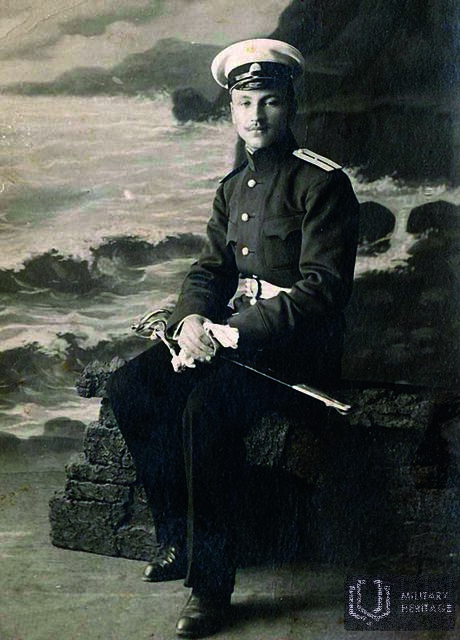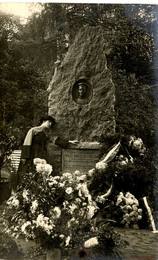Vilis Gelbe (also Gelbe, 1890-1919), naval lieutenant
I World War I, I Wars of Independence
Vilis Gelbe was born on November 8, 1890 in Zemīte. He graduated from a local school, Talsi city school, then Engure and Pēterpils naval schools. He received a diploma as a long-distance helmsman and, after graduating from the Oranienbaum naval school in July 1918, also a captain's diploma. During the First World War, he was the commander of the ships "Kotka" and "Arguņ", participating in operations against the Germans.
At the end of 1918, he arrived in Latvia and joined the Latvian Armed Forces. At the beginning of 1919, Vilis Gelbe operated in Northern Latvia liberated from the Bolsheviks, where he had to assume the duties of the commandant of the Valmiera district. He was one of those who practically worked on the creation of the Northern Latvia brigade, which, according to the agreement with Estonia, was formed under the command of the Estonian army. At the end of May 1919, Vilis Gelbe was commanded to Limbaži, which had already been occupied by Estonian soldiers without a fight, because the communists had fled to Valmiera. He was the first war commandant of Limbaži and the surrounding area. The formation of the first military units from Limbaži residents, including senior schoolchildren, began. Commander Vilis Gelbe had to operate in Limbaži and the surrounding area during a very difficult time, when preparations were underway for war with the German Iron Division and Landeswehr in the vast territory of Vidzeme, known as the Battle of Cēsis. The work was often complicated by everyday conflicts between local residents and Estonian soldiers.
During the Battle of Cēsis, Vilis Gelbe and his commandant's men participated in battles with the soldiers of the German Iron Division. On June 19, 1919, near the Vidriži Manor, Gelbe and his command went to attack the German outnumbered troops, with his bravery he encouraged the soldiers to fight, thus ensuring the right wing of our forces. During this battle, he fell a hero's death and was posthumously awarded the Lāčplēsis War Order, 3rd class, in 1921. Vilis Gelbe is buried in the Limbaži cemetery.
The gravestone of Vilis Gelbe was unveiled on September 10, 1922, by the then President of Latvia, Jānis Čakste. A memorial sign was also erected at the site of Vilis Gelbe's last battle in the Vidriži Manor Park.
More information sources
Jānis Ulmis "For the beloved fatherland...: Cavalier of the Lāčplēsis War Order, Naval Lieutenant Vilis Gelbe, on the formation of the Northern Latvian Armed Forces and the Cēsis Battles of the Latvian Liberation War". Limbaži: Limbaži Museum, 2018.
Jānis Ulmis. Cavalier of the Lāčplēsis War Order, Naval Lieutenant Vilis Gelbe, in the formation of the Northern Latvian Armed Forces and the Cēsis Battles of the Latvian Liberation War. (Book excerpts): https://limbazi.lv/novads/vesture/cesu-kaujas/6841-lacplesa-kara-ordena-kavaliera-juras-virsleitnantavila-gelbes-loma-ziemellatvijas-brunoto-speku-izveide-un-latvijas-atbrivosanas-kara-cesu-kaujas-landesvera-kara
Biography of Vilis Gelbe, Cavalier of the Lāčplēsis War Order: http://lkok.com/detail1.asp?ID=533
Related objects
A memorial in Vidriži at the place where LKOK Vilis Gelbe and two soldiers from his team fell.
In Vidriži, at the turnoff to Lēdurga, during the War of Independence on June 19, 1919, naval lieutenant Vilis Gelbe and two soldiers fell in battle.
Vilis Gelbe was buried in the Limbaži cemetery. For his heroic deed near the Vidriži manor, Vilis Gelbe was awarded the Lāčplēsis War Order, 3rd class (No. 895).
Currently, three Pemin crosses, installed in 1989, can be seen at the battle site.
On June 22, 1934, a bronze memorial plaque modeled after the artist Stefans Bercs was unveiled near the maple tree growing in the manor park. Already at the beginning of the communist occupation in the autumn of 1940, the memorial plaque disappeared. The maple tree to which it was nailed also perished. When the Awakening began, on June 19, 1989, on the 70th anniversary of the death of Gelbe and two soldiers from his team – Corporal Krustiņš and Private Krūze – at the crossroads where the memorial plaque once stood, at the initiative of the Environmental Protection Club and the Limbaži district branches of the Latvian Popular Front, three wooden crosses made in the folk style by Jānis Eglītis were installed. By decision of the Limbaži district executive committee in April 1991, this memorial site was included in the list of historical monuments of local importance.
Monument to Naval Lieutenant, L.k.o.k. Vilis Gelbes (1890-1919)
Located at the Limbaži Jūras Street Cemetery, Jūras Street 56, Limbaži
On display is a monument unveiled on September 10, 1922 by the then President of Latvia, Jānis Čakste, which contains the dedication of the poet Vilis Plūdonis to Vilis Gelb:
"My people, who pass by me, burn with love for your fatherland,
"For the sake of my beloved fatherland, I pledge my life."
Vilis Gelbe (1890-1919) was born in Courland, in Zemīte parish, but was also closely connected to the Limbaži side, because when the Latvian War of Independence began, he returned to Latvia from St. Petersburg and joined the North Latvian Brigade.
In May 1919, V. Gelbi commanded in Limbaži, he became the military commandant of the area and was able to inspire the local men and even very young boys to join the army.
V. Gelbe's activities in Limbaži and its surroundings at that time were very significant; his duties included not only maintaining order in the city and its surroundings, but also mobilization, providing food for soldiers and horses, and resolving many other issues that could not be included in orders and instructions. The commandant's team organized by him acted as a coordinated mechanism to provide the North Latvian Brigade with the most effective assistance possible. The commandant's team went to the aid of the regular army in special cases, and he set an example for the new soldiers. V. Gelbe was the first officer of the Latvian army who proposed awarding his subordinates with the Order of Imanta, Class III. The order did not yet exist. The name of Imanta appeared in public only on March 20, 1920, when a presentation on the establishment of a military order was submitted to the Minister of Security, Kārlis Ulmanis. However, the name of Lāčplēsis was chosen for the order.
During the Battle of Cēsis, Vilis Gelbe died - on June 19, 1919, during a reconnaissance mission. Gelbe was later awarded the Lāčplēsis War Order, but historians believe that his contribution has not been properly appreciated. This is mainly due to Gelbe's membership in the North Latvian Brigade.
The so-called Southern Latvian Brigade, initially commanded by Oskars Kaplaks and later by Jānis Baložs, competed with the Northern Latvian Brigade, commanded by Jorģis Zemitāns.
Monument in memory of the fallen soldiers of the Latvian Liberation War
The monument is located next to Limbaži Sv. St. John's Lutheran Church, Lībiešu Street 2. There is a memorial to the fallen soldiers of Limbaži and the surrounding area and to Lieutenant General Vilis Gelbe (1890-1919), who fell in the battle against the Germans on June 19, 1919 in Vidriži.
The monument of Lieutenant General Viļis Gelbe can be seen in the Limbaži cemetery in Jūras Street.
Related stories
About the national patriot First Lieutenant Vili Gelbi
The fate of Lieutenant Colonel Vilis Gelbe (1890-1919) reflects the difficult situation in the formation of our state and army, as well as the assessment of these events.
With the proclamation of the Latvian state on November 18, 1918, the Latvian War of Independence and the work of building the armed forces began. In the first ranks of the Latvian volunteer soldiers was the naval lieutenant Vilis Gelbe, who was born in Courland.
The beginning, course and conclusion of the Battle of Cēsis
The victory in the Battle of Cēsis was destined to become a turning point in the Latvian and Estonian struggle for the independence of their country. This victory put an end to the plans of the Andrievs Niedra government and the German general Rüdiger von der Goltz to conquer the Baltics. Instead, the Latvian Provisional Government of Kārlis Ulmanis resumed its activities in Liepāja.









![Limbaži. President J. Čakste unveils a monument in Limbaži to those who fell in World War I. Unveiling of the Latvian Freedom Struggle Monument [1923]. Source: The National Library of Latvia's digital collection "Lost Latvia".](/g/Poi/00403/44213.png?size=260)